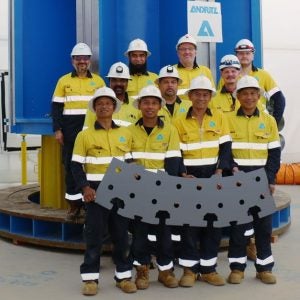InPipe Energy and Skagit Public Utility District have completed the East Division Street Energy Recovery Project at Skagit PUD’s East Division Street booster pump station in Mount Vernon – making the PUD one of the first water agencies to install a new technology that converts excess water pressure into electricity, reducing operational costs and helping to combat climate change.
Skagit PUD’s installation utilizes the In-PRV from InPipe Energy, a new smart water and micro-hydro system that generates electricity by harvesting excess pressure from municipal water pipelines. By recovering the energy embedded in excess water pressure and converting it into electricity, the system will generate up to 94,000 kilowatt-hours (kWh) or more of electricity per year while providing pressure management that helps save water and extend the life of the pipeline. The electricity produced will be used to offset the use of grid power at the pump station, saving Skagit PUD money and replacing the equivalent of 3.5 million pounds of fossil-fuel-based carbon emissions annually.
“Converting excess water pressure into clean, renewable energy is a win for the environment and our ratepayers,“ said George Sidhu, Skagit PUD General Manager. “Environmental stewardship is one of Skagit PUD’s core values; and in our actions, we want to preserve our region’s natural resources. As a public utility, we’re always looking to innovate and create greater efficiencies in the operation of our water system, and the East Division Street micro-hydro project checks all the boxes.”
“The world’s water infrastructure is energy and carbon intensive,” explained Gregg Semler, president and CEO of InPipe Energy. “We see a large, global opportunity for water agencies to meet their mission while also battling the impact of climate change. The sustainability of our nation’s water systems is paramount, yet water agencies are being constantly challenged with rising energy costs and aging infrastructure. By providing a more precise way to manage pressure in pipelines – while also producing electricity – our In-PRV product helps water agencies offset their energy costs while saving water, reducing carbon and extending the life of their infrastructure.”
The project was made possible with assistance from Puget Sound Energy (PSE), as part of their “Beyond Net Zero Carbon” initiative, and a Coal Transition Board Grant from TransAlta energy company. Through the initiative, PSE targets reduction of its own carbon emissions to net zero and goes beyond by helping other sectors to enable carbon reduction across the state of Washington.
“We value the opportunity to provide this energy efficiency program grant to Skagit PUD to help them be more efficient and build resilience,” said PSE President and CEO Mary Kipp. “This partnership reflects our commitment to combat climate change by reducing our own carbon emissions to net zero and helping other sectors to enable carbon reduction across the state of Washington.”
TransAlta, which is in the process of phasing out its last coal-fired power plant in Centralia, Wash., by 2025, has committed to supporting local communities and renewable energy development through its Coal Transition Board Grant process.
“We are committed to the development of innovative new forms of renewable energy, and this energy recovery project at Skagit PUD sets a great example for the role water utilities can play in making both water and energy more sustainable,” said John Kousinioris, CEO of TransAlta. “We are excited about the potential for the In-PRV to produce carbon-free electricity from water pipelines across North America.”
“Water is a critical resource in Skagit County as it relates to power generation, and this project demonstrates our regional leadership,” Sidhu said.
Skagit PUD’s pump station is the second installation of the In-PRV in a municipal water pipeline. The first, in the city of Hillsboro, Oregon, came online in September 2020 and is on track to produce 200,000 kWh or more of electricity each year.







